Which Fiskars Splitting Axe: How to Choose (I own them all)
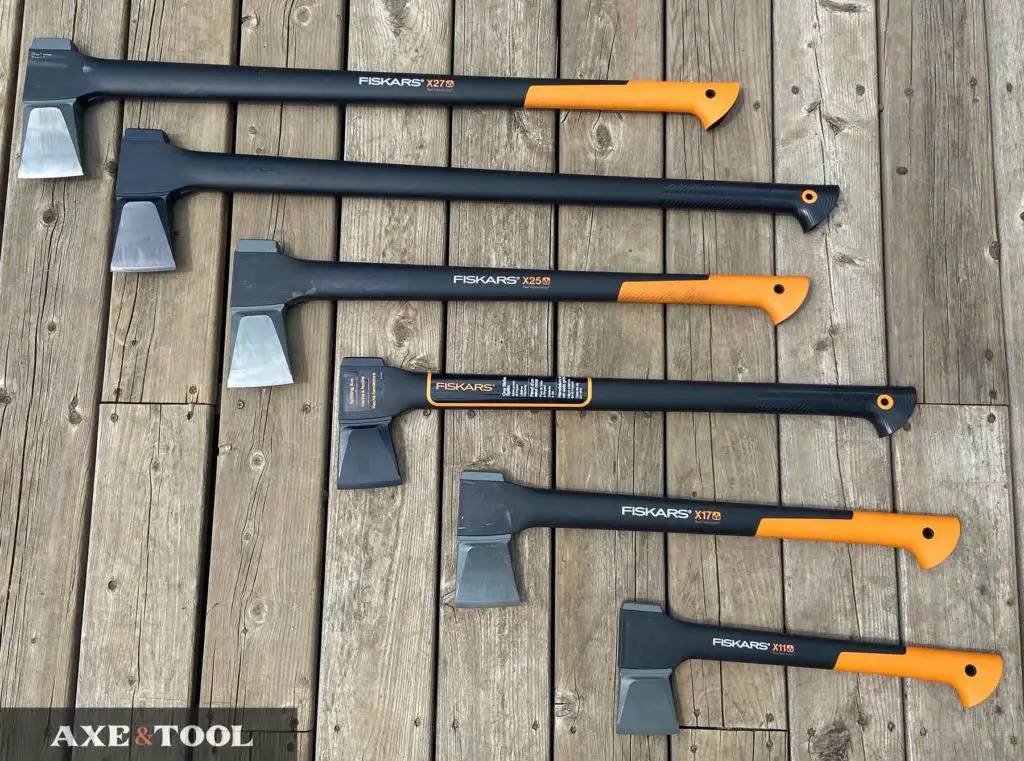
This is just a hobby, but if you buy through a link I may get a commission that supports the site. Thanks!
Fiskars splitting axes have a reputation as one of the best, high-value options on the market. But it can be frustrating trying to figure out which one to get. There are a lot of options, and many of them look almost identical.
Well, after my own frustration with choosing I now own them all. And after years of use, I’m hoping this article can help you decide.
| Jump Ahead | Length | Head Weight | Wood Size |
|---|---|---|---|
| Fiskars X27 | 36″ | 4lb | 12″ and up |
| 36” Super Splitter | 36″ | 4lb | 12″ and up |
| Fiskars X25 | 28″ | 4lb | 8″ and up |
| Fiskars X21 | 28″ | 2.5lb | 8″ – 12″ |
| 28” Splitting Axe | 28″ | 2.5lb | 8″ – 12″ |
| Fiskars X17 | 23.5″ | 2.5lb | 8″ – 12″ |
| Fiskars N12 | 20″ | 1.75lb | 4″ – 8″ |
| Fiskars X11 | 17 ⅜” | 1.75lb | 4″ – 8″ |
Note: The column of “wood size” is approximate as there are lots of factors involved. Wood type, log length, seasoning, temperature, and user all play a role.
What is the best Fiskars splitting axe?
No one axe will be perfect for every scenario. But, usually when someone asks for “the best”, they mean the most powerful.
The X27 is the best Fiskars splitting axe for pure splitting power. The 4lb head can split logs (24”+) and the 36″ length will maximize the swing force while reducing the chance of injury. Plus, the over-mold grip reduces vibration and fatigue. However, it can be less efficient in some scenarios.

The Fiskars X27 is what I recommend for most people, but I have a lot more info on this axe and others below.
The IsoCore Maul
Length: 36″ | Head Weight: 8lbs
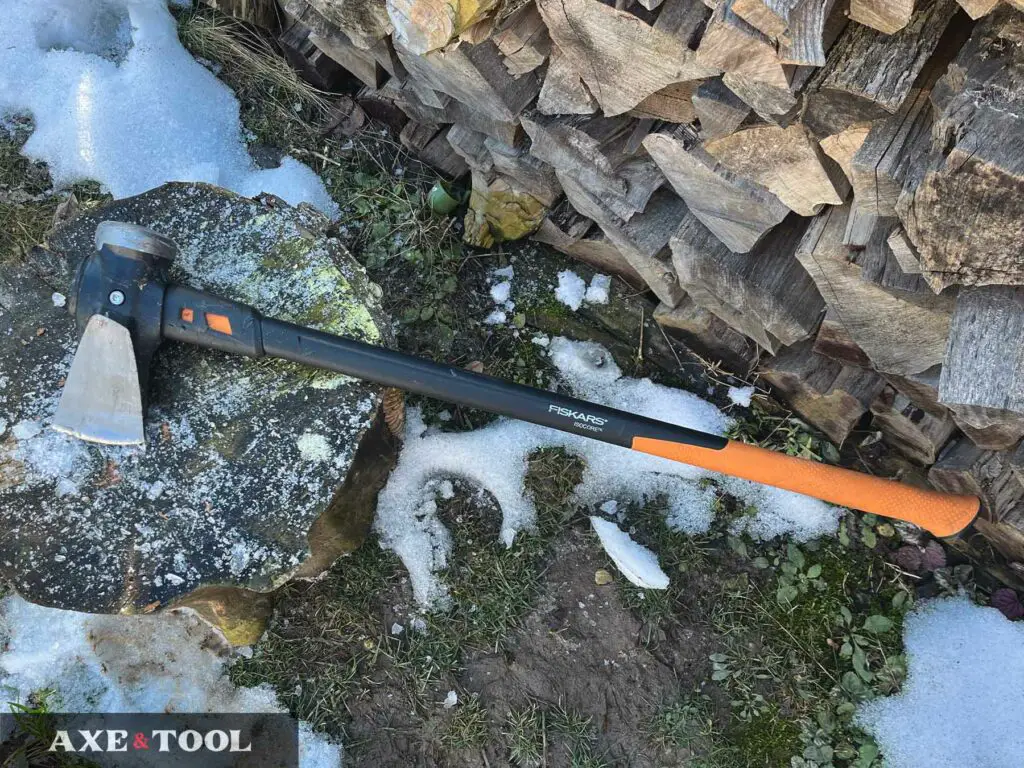
The IsoCore maul can be a good partner to a splitting axe, but likely shouldn’t be your primary splitting tool. It’s bigger and heavier for the toughest logs but is too heavy for extended use.
Splitting axes like the X27 are lighter, faster, can handle most tasks, and be used for longer without fatigue. For more details, I have an in-depth comparison of Fiskars splitting axes vs the IsoCore maul.
The Fiskars X27
Length: 36″ | Head Weight: 4lbs
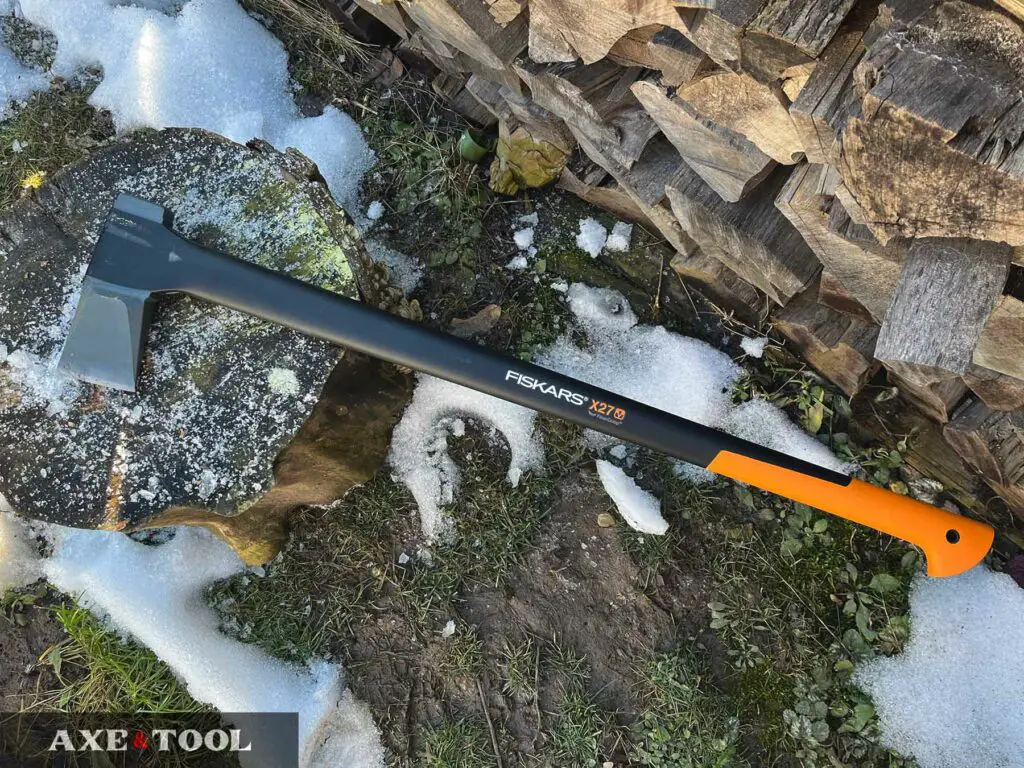
The Fiskars X27 is by far the most popular Fiskars splitting axe. It has a 4lb splitting head and a 36″ handle.
It’s the largest Fiskars splitting axe and can deliver quite a wallop. This axe is designed for the homestead, cottage, farm, etc., and can tackle the biggest rounds, but it is still light enough to swing for a long time.
Pros
Cons

Why I recommend the X27
The head is long, with 2 inches of standard blade shape before the cheeks flare out. This allows it to penetrate before forcing the wood apart. But even when it doesn’t split on the first strike, the wedge-shaped bit pops out pretty easily.
Something that often surprises people is that the biggest axes are also the safest. The 36” length guarantees a bad swing won’t ricochet and come back to hit your leg or foot (unless you are like 7’ tall).
I really think this is the best splitting axe for most people. The price is pretty consistent between retailers so it doesn’t really matter where you get it.
The Fiskars 36″ Super Splitter
Length: 36″ | Head Weight: 4lbs
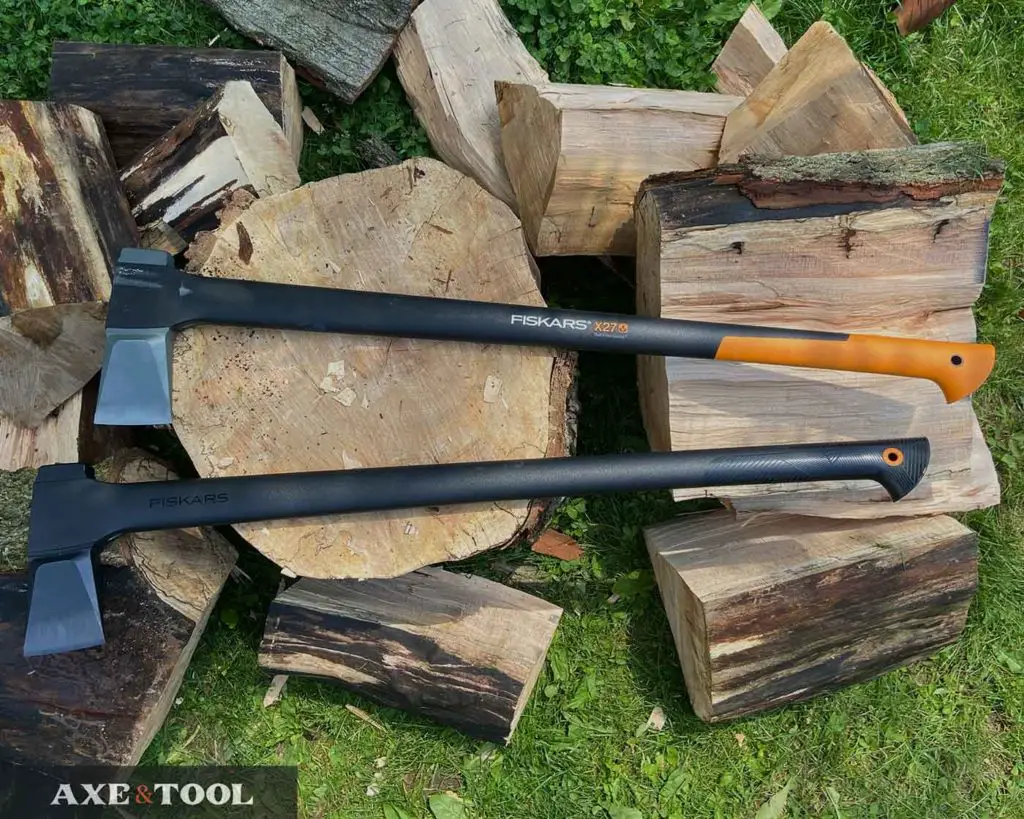
The black Fiskars 36” Super Splitter is identical to the Fiskars X27 in length, weight, head, and capability. The only difference is the thin orange rubber over-mold grip on the X27. The black axe has a molded textured grip which is harder on the hands with extended use.
Pros
Cons
I would pay the extra couple of bucks for the X27. The orange over-mold softens the impact vibration.
FiberComp handles reduce impact vibrations in general, but without the over-mold grip, you can feel the vibrations much more in your hands. The small price difference with the X27 is worth it to me after a few big swings.
The over-mold is also better to handle in cold or wet weather. The composite handle material can feel cold to the touch at lower temperatures, the over-mold helps with that
But if you would rather save a bit of money the Super Splitter performs just as well as the X27.
The Fiskars X25
Length: 28″ | Head Weight: 4lbs
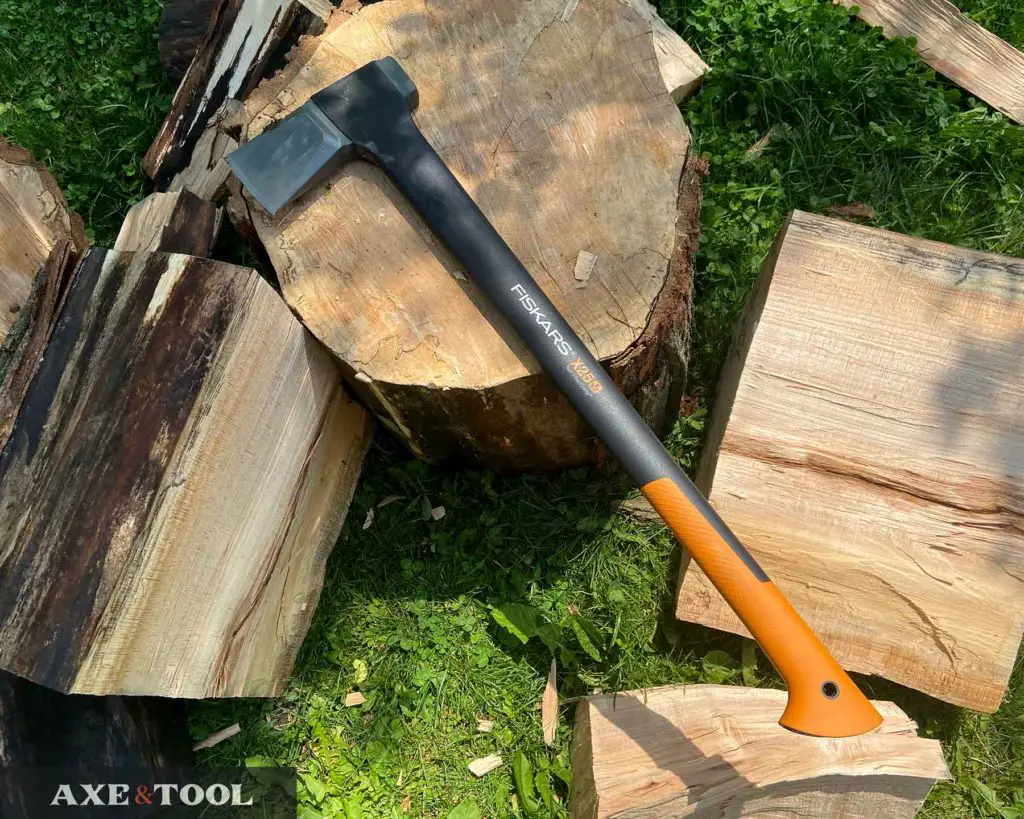
The Fiskars X25 has the same large 4lb head as the X27 but with a shorter overall length of 28.5” (vs 36”). The shorter length lowers the maximum potential force but makes it a more efficient, mobile, and accurate axe.
Pros
Cons
The shorter length is easier when working around a woodpile. You can keep moving and adjusting pieces of wood while you go. The 28” handle of the Fiskars X25 increases accuracy when swinging at a smaller target, and It doesn’t feel as much like overkill hitting a smaller log with a smaller axe.
A shorter axe is faster to swing and easier to swing longer. Even though the head is the same weight as the X27, it takes less time and effort to get the X25 back in position for another swing.
Obviously, you will get more power out of the longer 36” axe, but every swing after the initial split is at smaller easier pieces. I’d rather take 1-2 extra swings up front and have the rest be easier. However, there is a catch.

I did some head-to-head testing with some fresh-cut rounds between 20-24 inches. The X27 & X25 were almost matched stroke-for-stroke. Out of 10, there were 3 rounds the X27 fully split in fewer strokes.
The X25 can be more dangerous
The X27 is a safer axe because it’s basically impossible to get hit by the blade because of the 36″ handle. But the 28″ length of the X25 means if it passes through the log, it can swing back and hit you in the shin. Which is bad.
You need to be more conscious of your form and technique when working with axes this length. Especially if you are tall, you need to bend your knees to keep the blade from arching back towards you.
You want to bring the blade down on the log, not swing in a big arch.
For the record I’m 6’1”, and it’s not a big issue if you know what you are doing. But there is a risk if it’s used carelessly.
The X25 vs Fiskars Black 28” splitting axe
The X25 and Black 28” Splitting axes are NOT the same.
The Fiskars X25 has a large 4lb head like the X27, while the Black 28” Splitting Axe has a medium-sized 2.5lb head meant for smaller logs or smaller users. It actually matches the X21 which is a medium-size axe not available in North America.
The Fiskars 28″ Splitting Axe
& Fiskars X21
Length: 28″ | Head Weight: 2.5lbs
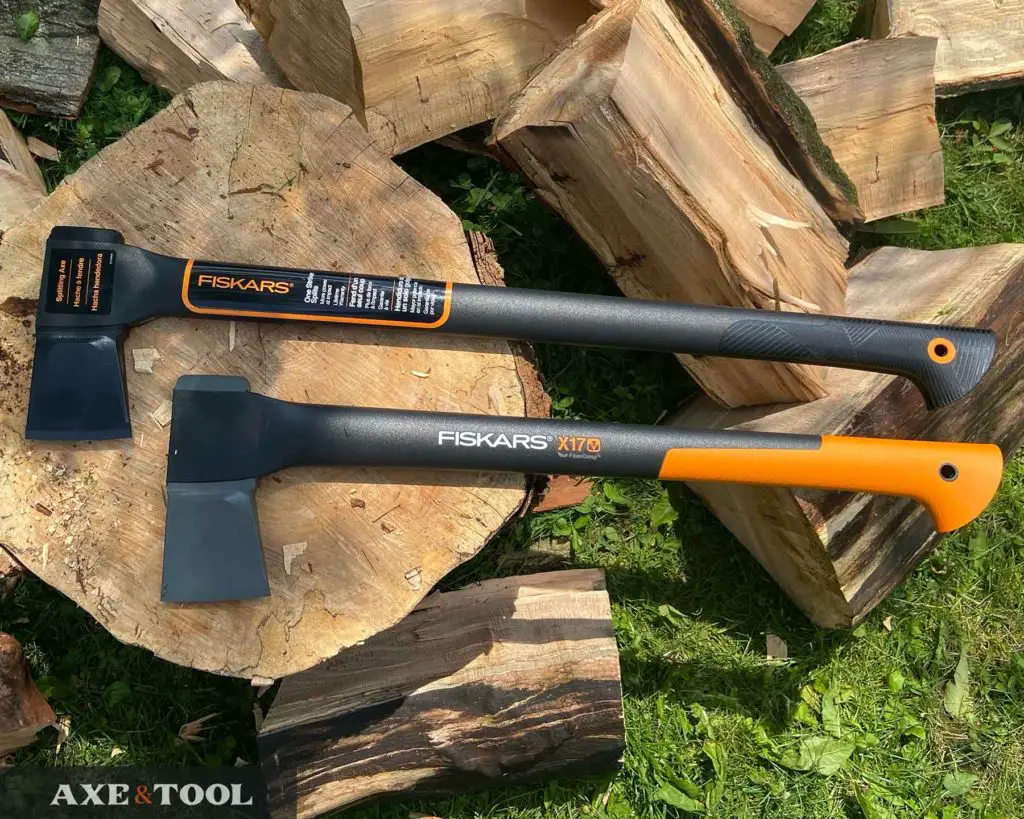
The Black Fiskars 28″ Splitting Axe has a mid-size 2.5lb head designed for splitting medium-sized logs (12″ and under) and is also a good option for younger users.
The X21 and Black 28″ Splitting Axe are identical, other than the black axe doesn’t have an over-mold grip.
The X21 is not available in North America, but the black 28” Splitting Axe is.
My theory is the X21 is not sold because the medium-sized head is underpowered for the large trees in North America. They want to steer people towards the bigger axes that make more sense as a dedicated splitter.
Pros
Cons

If you have wood that doesn’t get over 12” in diameter this could be a better option than the big axes.
You will be able to swing this light axe even longer without tiring out from the big overkill swings of the X27. The medium size head is best suited for 8-12” rounds. It can maybe push up to 16” – you just won’t get one-hit splits.
Like the X25, you need to be careful with the X21, and use proper technique. The lighter head and shorter handle can ricochet and cause injury.
The axe should be brought straight down on the wood not be swung in a big arc.
Even when it’s 10-12” wood I tend to go with the X25, as it offers more one-hit splits, and power to get through knotty wood.
The 28″ axes are great youth axes
It’s a more manageable weight and length that can still be useful. The splitting head is efficient and won’t get stuck even – with underpowered swings.
The Fiskars X17
Length: 23.5″ | Head Weight: 2.5lbs
The Fiskars X17 offers compact power. It has the same size head as the X21 and 28” Splitting axe just on a shorter 23.5” handle. It’s perfect for a firepit, or compact vehicle splitting axe.
Pros
Cons
I have been impressed it can still handle 12” logs quite easily and seems to be on par with the longer models. However, I would not use this as either a dedicated splitter or a youth axe.
The X17 is too small for a dedicated splitter. You want all the power you can get, and even while this works, it won’t have the same force potential as a 28”+ handle. And as a youth axe, I think it’s just too dangerous. Proper technique is too important to safely use this size axe to give to a young amateur.
The Fiskars X17 is too big for a pack
The medium-sized axe head (and resulting handle width) makes The Fiskars X17 and X15 axes too big and heavy for a pack or man-portable role. There are other 23″ axes that are more pack-friendly, but the robust design of the Fiskars is not one of them.
The X17 is ideal for a vehicle-splitting axe
The X17 splitting axe is great as a vehicle axe. It easily fits in a trunk, trailer, or RV for camping and on the back of an ATV for taking around the property. It’s too big for pre-cut firewood but is great for breaking up larger logs.
However, I almost always go for its chopping counterpart.
The Fiskars X15
Length: 23.5″ | Head Weight: 2.25lbs

While it’s not a splitting axe, the X15 is an excellent compact general-purpose axe that is good at splitting. The X15’s wedge-pattern head can still split up to 12” logs and will be much more useful if needed for other tasks (like clearing fallen trees or branches).
Pros
Cons
The head is slightly lighter and less flared. But, I tested the X17 and X15 side-by-side on around 12”x12” rounds. The X17 averaged 1-2 swings splits, while the X15 took 2-4.
The X15 is my go-to for a “big” compact axe. In fact one lives in the trunk of our vehicle year-round.
The Fiskars X11
Length: 17.375″ | Head Weight: 1.75lbs
The X11 should be a kindling contender for anyone who uses a woodpile. It’s my go-to for a smaller splitting on the property. It’s the smallest Fiskars splitting axe (just under 17.5” long), but that also makes it big enough to use two-handed.
Pros
Cons
This is perfect for the woodpile because you don’t need to switch between an axe and a hatchet. You can break down a wider range of smaller logs (maybe 7-8″) and already split wood.
The size and weight of the 1.75lb head take more experience to handle for making small tinder. The larger head can be clumsy for detailed work, and It can blow right through them with the potential for injury.
It’s not hard, it just takes practice and understanding to use it safely.
The Fiskars N12
Length: 20″ | Head Weight: 1.75lbs
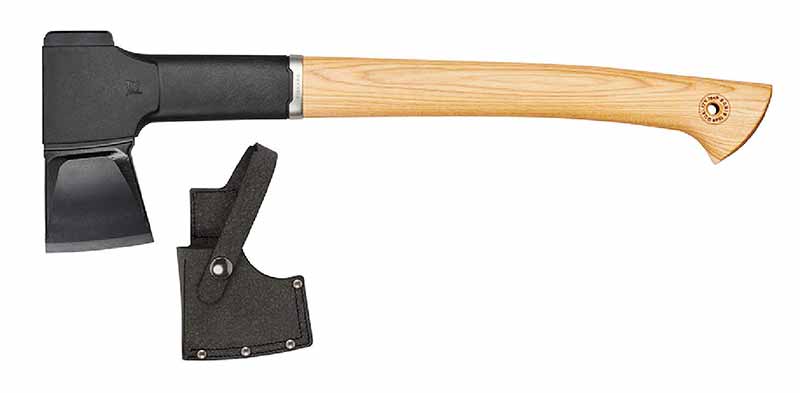
The Fiskars N12 has the same 1.75lb splitting head as the X11, but a longer 19” hybrid wood handle so it’s easier to use two-handed. The N12 also comes with a slim recycled leather sheath, instead of the standard plastic carrier.
Pros
Cons
The N12 is part of the Norden series and is the only splitting axe I don’t own (yet).
The Norden axes have a hybrid handle. The lower two-thirds are wood, while the top third is the Fiskars FiberComp to secure the head. This gives that traditional feel in hand plus the strength to withstand overstrikes. They also come with a slim/compact recycled leather sheath for packing light.
N12 vs X11 (Why I choose the X11)
This size axe (19”-21”) is my favorite, they are just fun. Compact but surprisingly efficient. The difference between 19” and 17.5” may not seem that big, but in-hand, it makes quite a big difference in balance and power.
It’s the largest axe size that can still reasonably be carried on a pack, as a companion to a light saw. But like the X11 it could also work well as a light axe for the woodpile.
I’m not convinced by the hybrid handle for long-term durability. I haven’t seen or heard of any issues yet (they’re only a couple of years old). The main reason I don’t own an N12 is the price.
The N12 is about $100(US), whereas my X11 was under $60. For me, it’s hard to justify spending that much on another Fiskars axe. But if you are looking for a hatchet that’s a little different, this could be a good choice.
Please comment below If I missed something or if you have any questions. I do my best to respond to everyone.
About the author:
About the author:
Jim Bell | Site Creator
I’m just a guy who likes axes. I got tired of only finding crap websites, so I set out to build a better one myself.
I’m also on Instagram: @axeandtool

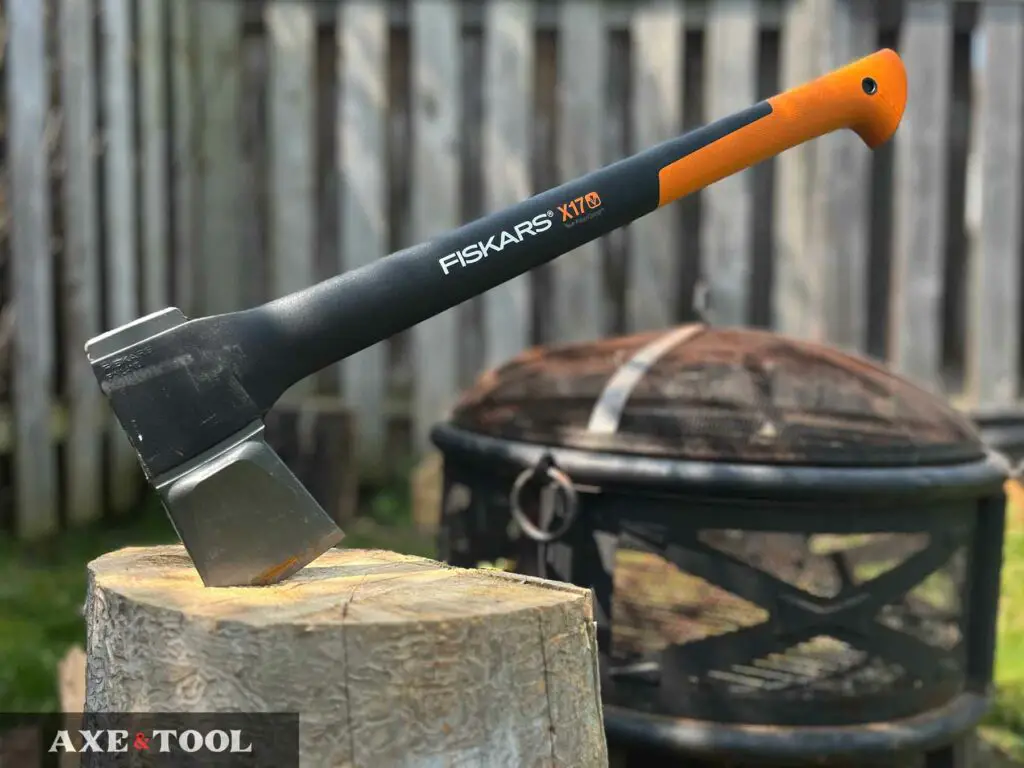








So I’m looking to have either just one all around camping ax or to keep in my truck…not too concerned about the cost…I’m more about practical. If I don’t use a tool I hate having it just sit there..what would be your go to all around ax…would u have the x15? Or should I have a splitting ax maybe x11 and also a chopping ax ?
I was thinking x7 in my rv, carry x15 in my truck…Anythjng larger I just use chainsaw
The X15 is a bit big for the campsite on its own – but I do exactly what you are saying.
When I use Fiskars (I test a lot of axes) I take the X7 for a campsite hatchet, it’s light and nimble for kindling or any light chopping. Then the X15 lives in the trunk of my SUV year-round for bigger tasks. I don’t mind if it goes long periods without use.
The X11 works on a campsite too, but I find I keep going back to the X7 for the small tasks.
If I had to pick just 1 camp axe, I might take the X10 (or Gerber version). It can split kindling like the X7 but has more chopping potential. But it would be under-powered if you needed any more serious splitting.
Hope this helps.
In my Humble Opinion. For splitting firewood the X 27 is All you need
I split 3 to 5 cords of wood a year and if the X27 can’t split it it gets thrown into the pile for a hydraulic splitter . There ain’t many the X27 cannot split. I’m 66 And have a bad back but using an X27 is a Pleasure
I agree – I really think it’s one of the best options out there for most people. Thanks for the comment, it’s great to get more perspectives on these things.
looking for suggestions for best Splitting axe perhaps for my size and stamina… I am female, small framed (slim), 118 pounds, short (5’2″) and lots of energy.
I heat my 700 sq. ft. home/art studio in Winters with a small wood stove (no longer than 11 inch will fit). I live in Missouri with good hard wood.
I have two cords brought to me cut at 10″ – 11″ but have to still split a lot of it. I have been using a hardware shop model Maul/Splitter, 34″ counting the axe yellow handled tool.
Depending on the wood, one blow with the splitter will get me through the wood but most time the splitter stays in the wood so I have to raise both and let the weight of the wood and of the weight with splitter – split the wood. (Which I never see pictured in any videos!) I do follow the wood lines (grains) of the wood to split but …Guess I’m doing something wrong. 🙂 Wrong strength or wrong tools? But good stamina and think this process should be easier on my body. Suggestions? Thank you!
First, you probably aren’t doing anything wrong. Sometimes your axe just gets stuck – or it takes a few hits (it happens to everyone). Most of the folks on YouTube edit that stuff out. Second, they are usually splitting green (fresh cut) wood, which is easier to split than seasoned firewood.
However, the 34″ axe might also be a little too big for you at 5’2. And it has nothing to do with strength, if you are splitting wood all winter I’m sure you have the muscle – but the long handle can make it harder to swing accurately with power. You might find a shorter 28″ axe a little handier for you.
The Fiskars X25 has the full weight splitting head, but a shorter 28″ handle. So you might find it easier to put your full strength behind the swing with confidence.
Alternately, the 28″ splitting axe has a lighter head. Which is still capable totally capable of splitting 10-11″, but you will probably get less “one-hit” splits. However, since it’s lighter you will be able to take those extra whacks more easily.
Overall, I find the Fiskars heads don’t get stuck as often as other designs – it can still happen, but they have a good design. If you don’t mind the weight of your current axe, I would try the X25. But, if you think your current one is too heavy, maybe try the lighter 28″ splitting axe.
Unfortunately, not many other companies make these shorter splitting axes – they are typically the big 34-36″.
Hope this helps!
Are there 2 different lengths for x25 and x27? I find 2 different barcodes with different lenghts for each at many stores.
As far as I know, there is only one size for each axe – X25 (28″) and X27 (36″). And those 2 axes are identical other than length. However – Fiskars a tendency to do things differently in different regions, so it’s possible they have a unique offering where you are?
Doggone you anyway! I have ten wonderful, (I thought), old axes and hatchets.
After reading your GREAT articles on the Fiskars axes, hatchets, and mauls, I bought FIVE Fiskars this week, with the probability of buying three or four more next month!
I’m 68, and recently had a tree fall in my back yard. As I have a couple of Solo stoves and a fireplace, I thought I would process the tree.
I thought I was doing OK splitting, until I brought home the 36 inch Super Splitter. It didn’t take more than a half a dozen strikes to get me converted. So down the rabbit hole I go.
Thanks again for the great review!
Ha! Thanks for the great comment, you can never have too many axes. I always enjoy an old wood handle, but the Fiskars are hard to beat. Glad you found the posts useful.
…I used my 2.5 lb maul for most of the morning today. It will bust open surprisingly large logs. But like Roy Weatherby said; speed kills!
It makes a huge difference in it’s capability if you get it moving swiftly enough.
That being said; I am finding it hard to warm up to it. Even though it is relatively small; in my limited experience; it seems somewhat clumsy in use.
Maybe it’s because all that weight is concentrated in such a small area.
My take so far is that I prefer using axes and hatchets on those pieces where a maul of that size would come into play.
Let us know your thoughts after you get yours.😁
Thank you for the excellent information about Fiskars splitting axes. You pulled all the info I was looking for together in a concise manner. You managed to not come across as condescending or preachy and that is important! It will be the x25 for my next Fiskars purchase.
Thanks so much, and I’m glad you found it useful (and that I don’t come across as a jerk). But seriously, I spend a fair amount of time trying to balance being detailed vs concise, so I appreciate the comment. Once you put that X25 to work, feel free to let me know if you have a different perspective.
I have a few too. Normally I bring the X25 and the isocore maul with me. The X25 is significantly more accurate and if it’s too big I use the maul, often with wedges. X27 is probably the most fun to use though and with the weight so far forward the swing speed is incredible.
Couldn’t agree more. The X25 is my goto, and pairing with the Maul is a killer combo. Thanks for the comment
Nice breakdown, thanks.
Maybe you could recommend one for me. I’m buying seasoned, split hardwood for my wood burning smoker. I need to split the splits down further to about 3-4″ diameter to be the right size for my smoker. It seems like any of the big axes, x27, x25 will be major overkill for this (I do also already have a 6lb maul).
I’m leaning towards a x11 or x17 for splitting these splits down further, but not sure which one to get. I don’t need a lot of power as the splits probably won’t be more than 8-10″, but seems like the x17 might be a bit more versatile. Maybe I just need a hatchet to replace the one I lost. I’m a 6ft male if that matters.
Thanks
Since you are buying seasoned wood, I think the X17 is probably the better choice than the X11. I have been using the X17 more this summer, and it has really grown on me. The X11 could do it, but would take more work and probably be a pain if you are splitting a bunch.
Hope this helps.
Thanks for the recommendation. Pretty much all of my wood will need to get get split down to the 3-4″ diameter. Anything larger causes too great of temperature spike when I add a split to the fire when smoking. I’ll probably burn through a 1/4 cord in 3-4 months. So that’s the same amount I’ll need to split. So X17 over X11 seems like a good idea. Do you think the X21/28″ black splitter is a better choice than the X17? Same head, 24 vs 28 inch handle? Or will the extra length of the 28″ make it difficult to be accurate in splitting splits down to 3-4″? Thanks.
Do you think the X21/28″ splitter is too long for this job of splitting splits down smaller? Will it be too inaccurate vs the x17? Since they have the same head…
I don’t think it will make a big difference, you can always just choke up a little on the 28″ if needed. The 28″ handle might save your back a little (don’t need to bend as far), but I think either would work well.
Is it safe to drive steel wedges with any of the splitting axes?
My go-to axe is the X17. I have an iso-core maul for the bigger stuff but I’m ageing out of tolerating the stress, I’d like to swap it out for an X25 which would let me split some bigger stuff with a lot less stress but there will still be those few tough pieces that will need wedges.
I’m a 5″ 3″ older guy, and a wood burner for most of the last 40 years. I don’t process grapple-loads any more; now I buy it cut, split, and dropped. But having a parlor stove means always finding a good number of splits that don’t fit.
None of the Fiskars axes are good for driving wedges unfortunately. But, Husqvarna makes a similar axe that does have a hardened pole and a good reputation. They make a 28″ version similar to the X25 (see here). I haven’t tried this specific model, but I have one of the hatchets.
I’ll look into that – thank you for suggesting it.
Great article!
What axe would you recommend for removing tree stumps and stump roots on a hillside in a backyard? (may also occasionally be used to chop up some large tree limbs into firewood)
I just bought the Fiskars 36″ 5lb splitting pick and X7 hatchet yesterday, thinking the pair could do the trick. Now after reading your article I’m wondering if I should return and get one of the bigger axes reviewed here…or something else altogether, like a pulaski or cutter mattock?
Any thoughts? Thanks in advance!
I’ll be honest, I haven’t done a lot of stump removals, and I haven’t tried the Fiskars pick. But also, how big a trees are we talking?
For smaller tress, I would think the X7 and Mattock end of the pick should be fine for the roots ( pick is maybe looks a little narrow), and it’s length will probably help for prying them up. But if you are getting into medium or large trees, you likely need a more substantial chopping axe to help break through the stump and larger roots. I wouldn’t use a splitting axe.
A Pulaski could be a good choice if you just want a single tool to carry. But a separate axe and pick might give you a little better version of both.
Like I said, I’m not an expert for this task, but hope this helps some?
You didn’t mention what kind of wood you were splitting. I’d bet serious money you can’t split a 16″ long piece of 24″ diameter beech in one stroke across the center with *any* handheld tool. Dead, dry spruce or fir, sure, no problem. Dead, dry ash, sure if you split shingles off the outside. I have some unknown species local wood where my x25 literally bounces off without leaving a mark unless I hit it as hard as I can, and then I may just get stuck. I use an estwing wedge and an 8# sledge for stubborn pieces.
Thats a very fair point, it’s been a couple years since I took those pictures but I bet it was maple. That’s usually what I am splitting – sometimes ash. I might need to put some more thought into how I describe that, or at least give that caveat. Same with green vs seasoned wood. There are so many conditional factors with wood, it can be tricky. I appreciate the insight, and I will try and figure out how to add some of this to the article.
Excellent article. I was wondering which axe would you pick for car camping / splitting pre cut logs for campfires?
I would (and do) take the X11. It’s more than capable of busting campsite logs. Since it’s still a hatchet, you will have to crouch down or kneel to use it – so if that’s an issue X17 would the next choice. But I think it’s overkill if the crouching isn’t a problem. Hope this helps.